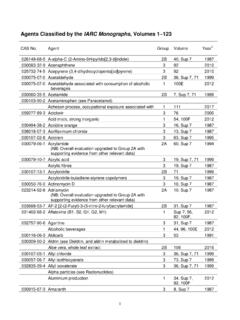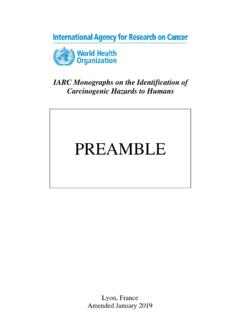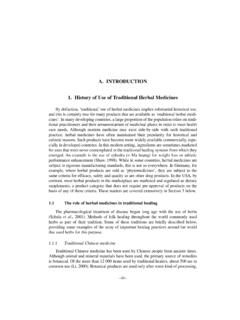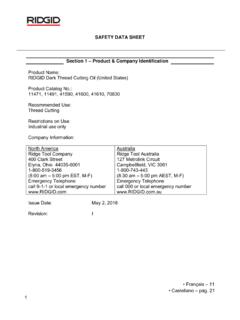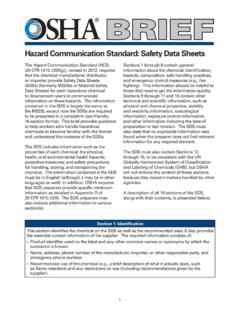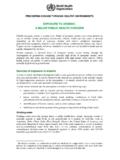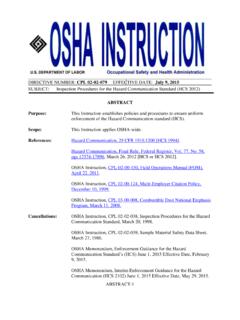Transcription of ALOE VERA - IARC Monographs on the Identification of ...
1 371. Exposure DataThe first record of human use of aloe vera is in Sumerian hieroglyphics engraved on clay tablets during the Mesopotamia civilization circa 2200 BC, in which it is described as a laxative. Use of aloe in ancient times is also documented in Egypt, Greece, and China. aloe vera was culti-vated on the islands of Barbados and Curacao in the Caribbean by Spain and the Netherlands, and was sold in various parts of Europe during the 17th century (Park & Jo, 2006). Commercial cultivation of aloe vera in the USA began in the 1920s in Florida (Grindlay & Reynolds, 1986). Although aloe vera originated in the warm, dry climates of Africa, the plant is readily adaptable and grows worldwide (Steenkamp & Stewart, 2007).Use of aloe vera gel extracts in health foods and beverages, and moisturizing cosmetics, began during the 1970s, starting in the USA and parts of Europe (Park & Jo, 2006).
2 H istor ic a l ly, aloe vera was used topically to heal wounds and for various skin conditions, and orally as a laxa-tive (Steenkamp & Stewart, 2007). The dried latex of other aloe species, such as aloe ferox Miller (Cape aloe or bitter aloe ) has also been used as a laxative (EMA, 2006). Today, aloe vera is also used as a folk or traditional remedy for a variety of conditions and is found in some dietary supplements and food products. aloe vera gel can be found in hundreds of skin products, including lotions and sunblocks (NCCA M, 2012).A glossary of commonly used terms for aloe vera products is provided in Table Identification of the Botanical data(a) NomenclatureFor details on botanical nomenclature, see Newton (2004).Chem. Abstr. Serv. Reg. No.: 80 01-97- 6 Chem. Abstr. Name: aloe barbadensisBotanical name: aloe vera (L.)
3 Burm. f. (sy nony m, aloe barbadensis, aloe humilis Blanco, aloe indica Royle, nomen nudum, aloe perfoliata var. vera L., aloe vulgaris Lam.) (GR IN, 2013).Family: XanthorrhoeaceaeGenus: AloePlant part: LeafCommon names: aloe vera ; aloe vera Linn ; True aloe ; aloe barbadensis; Barbados aloe ; Cura ao aloe ; Mediterranean aloe ; Ghritakumari; Lu Hui; Luhui, WHO (1999), Eur Ph (2008), O Neil et al. (2006), SciFinder (2013), IASC (2013a), Boudreau et al. (2013a). aloe VERAIARC Monographs 10838(b) DescriptionAloes are perennial succulents or xero-phytes; they can adapt to habitats with low or erratic water availability, are characterized by the capacity to store large volumes of water in their tissue, and are able to use crassulacean acid metabolism, an adaptation to the photosynthetic pathway that involves the formation of malic acid (Boudreau et al.)
4 , 2013a). aloe plants, such as aloe vera (Fig. ), all have green fleshy leaves covered by a thick cuticle or rind, under which is a thin vascular layer covering an inner clear pulp (Boudreau et al., 2013a; Fig. ) The leaves are 30 50 cm in length and 10 cm in width at the base, pea-green in colour (when young spotted with white), and with bright yellow tubular flowers 25 35 cm in length arranged in a slender loose spike (WHO, 1999).The vascular bundles, located within the leaf pulp, transport (i) water and minerals from the roots to the leaves; (ii) synthesized materials to the roots; and (iii) latex along the margins of the leaf for storage (Ni et al., 2004; Fig. ). The number of vascular bundles varies depending on the size of the leaves and the age of the plant (Ni et al., 2004). aloe vera plants contain two major liquid materials (Fig.
5 : first, a bitter yellow latex located under the strongly cutinized epidermis of the leaves in the vascular layer and containing a high concentration of anthraquinone compounds, which has been used throughout the centuries as a cathartic and for medicinal purges; and, second, a clear mucilaginous gel produced by the thin-walled tubular cells in the inner central zone (parenchyma) that has been used since ancient times to treat burns and other wounds, where it is thought to increase the rate of healing and reduce the risk of infection (Joseph & Raj, 2010). A third liquid may also be obtained by macerating the whole leaf.[Both the scientific and the lay literature ( on internet sites) are extremely inconsistent when referring to products obtained from aloe vera . The problem starts with the fact that the three types of liquids that are obtained from aloe vera leaves are interchangeably referred to as aloe juice, which has caused confusion in the literature.]
6 For disambiguation reasons, the term aloe juice should be restricted if used at all to the latex material of the pericycle, which is in accordance with the pharmacopoeial definitions Table Definition of terms commonly used in the aloe industryTe r mDefinitionLeafThe part of the aloe vera plant used in commerce, where processing is begun without stripping off the leafHistorically used to describe products derived from the entire leaf that were filtered/purified. However, use of this terminology without adequate additional descriptors is not recommended. This terminology is now seen on products or in reference to raw material where the entire leaf is used as a starting ingredient to create aloe vera whole leafA process, usually involving filtration with activated charcoal, that clarifies the liquid aloe leafPlant part used to describe the clear, central parenchymatous tissues of the aloe latexBrown, yellow-brown, or occasionally red exudate found between the rind and inner leaf.
7 Also called sap, it contains several constituents, but most notably organic compound primarily found in the aloe latex, whose structure serves as the basic building block for several naturally occurring plant pigments. The substance is commonly used for laxative product typically derived from the inner product derived from aloe vera leaf [the Working Group noted that the term juice is used arbitrarily and may either apply to products from the latex or from the gel].Adapted from IASC (2009) aloe vera39(WHO, 1999; Eur Ph, 2008; JP XVI, 2011); and the inner leaf liquid material should be referred to as gel (WHO, 1999). Interchangable terms found in the literature for the gel are inner pulp, mucilage tissue, mucilaginous gel, muci-laginous jelly, inner gel, and leaf parenchyma tissue (Hamman, 2008).] Chemical constituents and their propertiesA review of the chemistry of aloe vera was provided by Reynolds (2004), and a summary of the chemical constituents of aloe vera is provided in Table main feature of the aloe vera plant is its high water content, ranging from 99% to , while the remaining solid material is reported to contain over 200 different poten-tially active compounds, including vitamins, minerals, enzymes, simple and complex poly-saccharides, phenolic compounds, and organic acids (Boudreau et al.)
8 , 2013a; Rodr guez et al., 2010).In compositional studies on the structural components of leaf portions of the aloe vera plant, the rind was found to compose 20 30% and the pulp 70 80% of the whole leaf weight. On a dry-weight basis, the rind and pulp contain and lipids, and and proteins, respectively (Femenia et al., 1999). The percentages of soluble sugars ( and ), primarily as glucose, and the percentages of ash ( and ), in particular calcium, were relatively high in the rind and pulp, respectively. Non-starch polysaccharides and lignin repre-sented the bulk of each leaf fraction and were found to be and of the dry weight of the rind and pulp, respectively (Boudreau et al., 2013a). Acetylated mannan is the primary poly-saccharide in aloe vera gel (Ni et al., 2004). Other chemical constituents of aloe vera include lectins such as aloctins A and B (Kuzuya et al.
9 , 2004).The physical and chemical constituents of the products derived from aloe vera plants differ depending on the source ( part of the plant), the species of the plant, the climate conditions, seasonal and grower influences (Boudreau et al., 2013a), and processing techniques (Wa l ler et al., 2004). Technical and commercial productsThree types of aloe vera extracts can be distinguished gel extract, whole leaf extract, and decolorized whole leaf extract (Boudreau et al., 2013a), and a fourth type of commercial material is available as dried latex, which has Fig. aloe vera (L.) Burm. F, plant and flowerFrom Spohn (2013) Roland SpohnIARC Monographs 10840been traditionally used as the laxative (Eur Ph, 2008).(a) aloe vera gel extractThe inner leaf pulp of the aloe vera plant contains large, thin-walled cells that produce gel, the clear, mucilaginous, and aqueous extract of the inner central area of the leaf pulp (Fig.
10 aloe vera gel serves as the water and energy storage component of the plant. The mechanical extrusion of the mucilaginous gel from the inner leaf pulp gives a 70% yield with a water content of 99 (Femenia et al., 1999).Polysaccharides in aloe vera gel consist of linear chains of glucose and mannose molecules, and, because there is considerably more mannose present than glucose, the molecules are referred to as polymannans. These linear chains range in size from a few to several thousand mono-saccharide molecules. The major polysaccha-ride, acetylated mannan, is composed of one or more polymers of various chain lengths with molecular weights ranging from 30 to 40 kDa or greater, and consisting of repeating units of glucose and mannose in a 1:3 ratio (Channe Gowda et al., 1979; Mandal & Das, 1980; Ya ron , 1993; Femenia et al.)
